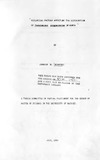Ecological factors affecting the distribution of pseudomonas solanacearum in Kenya

View/
Date
1982Author
Nyaangeri, Johnson B
Type
ThesisLanguage
enMetadata
Show full item recordAbstract
One hundred and thirty-eight potato farms were examined
for the presence of bacterial wilt in Central,Eastern and
Rift Valley Provinces. The altitude of these areas ranged
from 1390 m to 2790 m above the sea level and the mean annual
o
temperatures ranged from 12.1 C to 21.2oC. Twenty-one per
cent of the farms were found infested with bacterial wilt.
The highest percentage of infested farms lay between an
altitude of 1520 m and 2120 m. The disease incidences decreased
with elevations outside this zone.
Disease symptoms were used to identify diseased plants
in the field. Thirty-three isolates collected were classified
as Pseudomonas solanacearum biochemical type II or race
3 of Buddenhagen, et ale (1962). Potatoes (Solanum tuberosum)
were infected exclusively by this biochemical type. Biochemical
type III was isolated from egg-plant (s.
melongena). This biotype was not isolated from potataes and
was not found pathogenic to potatoes.
The optimum growth temperature of f. solanacearum in
The minimum and maximum temperatures were
around 13°C and 35°C respectively. No growth was obtained
at 12°C and 37°C. The in vivo growth-chamber inoculation
experiments showed an increase in the rate of wilt development
as temperatures increased from 14°C to 24°C. At higher
temperatures, the rate of wilt development decreased. Dose
xiv
response experiments in the greenhouse during four seasons
of the year showed that the concentration of viable cells
required for 50% of inoculated plants to wilt decreased with
o 0
an increase in temperature from 16.9 C to 20.7 C.
The pathogen survived best in soil at 24°C followed
o 0 l by 20 C and then 18 C. At these temperatures the bacteria
multiplied, reached a peak in the 14th day, then declined
slightly. The bacterial population remained almost constant
for 28 days at 14°C while at 28,30 and 33°C, the concentrations
of bacteria declined.
Most plants in0culated with the pathogen at high
altitude had latent infection. When tubers from these plants
were kept in humid conditions at 30oC, 20% showed disease
symptoms. .E. 80lanacearum was isolated from 3% of externally
symptomless tubers and 14.9% of plants raised from symptomless
tubers developed wilt symptoms under favourable conditions.
P. solanacearum is a good immunogen. Antisera pr-epar-ed
against the bacterium had titres ranging from 1/128 to 1/1024.
The antisera were found to be specific and could be used in
the laboratory for quick identification of E. solanacearum.
Citation
A thesis submitted in partial fulfilment for the degree of master of science in agronomy in the University of Nairobi.Publisher
Plant Science & Crop Protection, University of Nairobi
